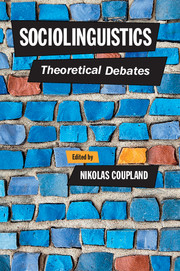Book contents
- Frontmatter
- Contents
- List of contributors
- Preface and acknowledgements
- 1 Introduction: Sociolinguistic theory and the practice of sociolinguistics
- Part I Theorising social meaning
- Part II Language, markets and materiality
- Part III Sociolinguistics, place and mobility
- Part IV Power, mediation and critical sociolinguistics
- 12 Critical debates: Discourse, boundaries and social change
- 13 Theorizing media, mediation and mediatization
- 14 Foucault, Gumperz and governmentality: Interaction, power and subjectivity in the twenty-first century
- Part V Sociolinguistics, contexts and impact
- Part VI The evolution of sociolinguistic theory
- Index
- References
13 - Theorizing media, mediation and mediatization
from Part IV - Power, mediation and critical sociolinguistics
Published online by Cambridge University Press: 05 June 2016
- Frontmatter
- Contents
- List of contributors
- Preface and acknowledgements
- 1 Introduction: Sociolinguistic theory and the practice of sociolinguistics
- Part I Theorising social meaning
- Part II Language, markets and materiality
- Part III Sociolinguistics, place and mobility
- Part IV Power, mediation and critical sociolinguistics
- 12 Critical debates: Discourse, boundaries and social change
- 13 Theorizing media, mediation and mediatization
- 14 Foucault, Gumperz and governmentality: Interaction, power and subjectivity in the twenty-first century
- Part V Sociolinguistics, contexts and impact
- Part VI The evolution of sociolinguistic theory
- Index
- References
Summary
Introduction
Sociolinguistics is currently facing the challenge of how to conceptualize the rapid expansion of its main object of study, socially meaningful linguistic differentiation, beyond the domain of spoken language in face-to-face interaction. This expansion moves into two distinct but interrelated directions: the rise of digitally mediated language as a new type of everyday language-in-use, and the circuit of mediatized representation, uptake, and recontextualization of linguistic fragments. This chapter discusses the three concepts flagged in the title in terms of their status in sociolinguistic theory and their usefulness in responding to these processes.
Discussing media, I first suggest that the concept is currently either erased from the discipline's canonical knowledge or reified as a catch-all notion that obscures the differentiation of the domain it denotes. I also suggest that a lot of thinking about language and media in sociolinguistics is shaped by metaphors which obscure, rather than illuminate, this relationship. Ultimately, I argue, ‘the media’, widespread as it might be as a descriptive cover term, is a theoretical cul-de-sac. Instead, understanding the implications of media for linguistic differentiation and its social meaning will fare better with conceptual alternatives, including mediation and mediatization.
Discussing mediation, I develop an understanding of the term that centres on technologically facilitated production and reception of linguistic signs. Digitally mediated written language represents a historically new type of mediation, which boosts the importance of writing as an everyday modality of language. I suggest that the sociolinguistic impact of digital mediation is more than its being a written representation of preexisting spoken-language variability and that we need to understand how digital mediation expands the boundaries of visually constituted linguistic heterogeneity.
Discussing mediatization, I introduce the concept's currently predominant readings in linguistic anthropology and communication studies and explore their implications for the study of sociolinguistic differentiation and change. These include the mediatized representation of sociolinguistic differentiation and its language-ideological implications, techniques of staging involved in these representations, and practices of uptake and circulation. Overall, I argue that mediatization and mediation take us further in opening up the black-box notion of ‘the media’, in transgressing unproductive distinctions such as the one between ‘mass’ and ‘new media’, and in understanding media in terms of performance, staging, uptake, and recontextualization.
- Type
- Chapter
- Information
- SociolinguisticsTheoretical Debates, pp. 282 - 302Publisher: Cambridge University PressPrint publication year: 2016
References
- 30
- Cited by



